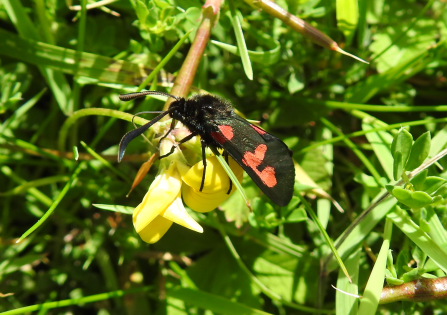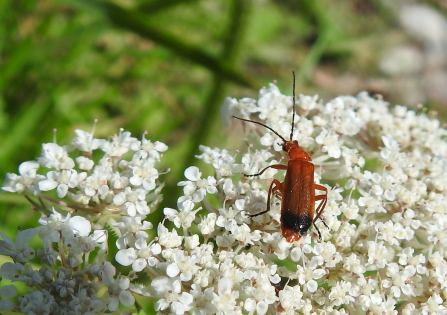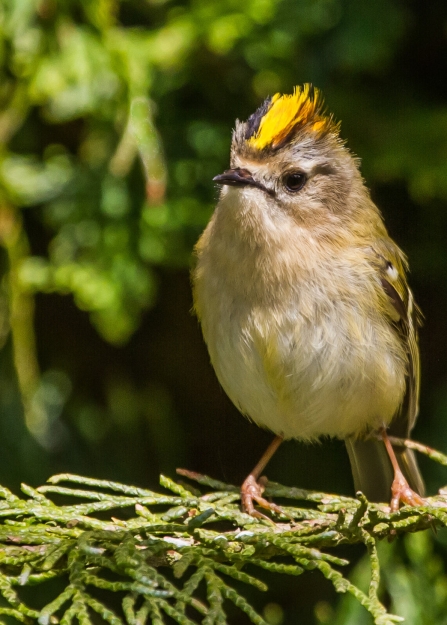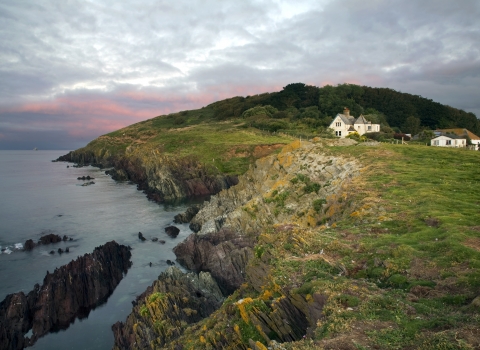Did you know that we have found crystals on the island? Not tiny little crystals that you’d find in a delicate piece of jewellery but ones that could fill the palm of your hand. Incredible, eh? Look, here’s picture evidence:
29th June 2020 - Looe Island Nature Highlights
1. Flying gulls by Claire Lewis
Each week I’ll try to share some of the things we’ve seen, heard or smelt (!) on the island. Hopefully by following my blog you’ll get a sense of what it’s like on Looe Island Nature Reserve and when we open later this year, you might just want to come over on the ferry and visit!
Crystal jelly by Claire Lewis
So, OK, I admit, these Crystal ‘Jellyfish’ aren’t going to make us a rich but we are fortunate to see such marine treasures. We first started spotting these pretty clear jellies back in 2013 and last week some more turned up. Crystal Jellies are pretty rare in UK waters but perhaps with warming oceans we’ll see more of them?
The teeny weeny stuff
I do love a day flying moth and right now we are spotting lots of burnet moths.

Burnet Moth
They are brightly marked by red spots on subtly iridescent dark green wings. Counting the number of spots on each forewing can help identify the species …but this is easier said than done as some of those darn spots merge, are there 5 spots or 6? Oh and sometimes you even find burnet moths with yellow spots instead of red – now that’s just not playing fair is it?
Their caterpillars generally feed on bird's-foot trefoil, and there’s plenty of that little plant growing here. And this is where it gets interesting: the caterpillars collect a poison from the trefoil called hydrogen cyanide. The deadly chemical stays in their bodies as they metamorphose into adult moths. Now you’d think the moth’s bright colours would warn predators that they should stay clear but if that fails, the moth oozes the cyanide poison its mouth and leg joints – yuck!
Atteeeention! Soldier beetles about. We are seeing lots of these narrow bodied insects assembling on flower heads.

Soldier beetle by Claire Lewis
Apparently there are about 40 different species of soldier beetle in Britain so I used Mark Gurney’s on-line guide to try and work out which we’ve been spotting. Conclusion? I reckon we find a lot of Rhagonycha fulva. They parade about in reddy orange military ‘uniforms’ with distinctive black tips to their wing cases – very smart.
Their reddy colouring means that some people call them Bloodsucker beetles – but don’t worry they aren’t interested in you. As adults they tend to feed on aphids but they aren’t fussy as they’ll also eat pollen and nectar too. Another great name for them is ‘bonk beetles’. Guess why? Yeap – they just seem to spend a lot of their time together… mating!
The greeny stuff
At this time of year the island has wonderful tall stands of pink bloomed tree mallow and the bees love it!
The flowers start off beautifully wrapped into a spiralled cone. Once un-twirled they show off their pinky purple petals with dark mauve veins. Lovely!
Bumblebee in tree mallow flower
This plant is often found by the coast as it can cope with the salty sea air and it thrives in nutrient rich areas. So on the island it grows in dense patches amongst the sea bird pooh or ‘guano’ – you see even plants know how to make the most of a natural resource.
The mallow’s soft velvety leaves are actually covered in glands – not a word you often associate with plants. The glands are there to let the plant excrete all the extra salt. You see it’s a salty sea dog of a plant - even its seeds are ‘sea proof’. The seeds have a tough coating that stops the salt water being absorbed and this helps seed float to new shores …. allowing more humans and other wildlife to enjoy those pretty pink flowers.
Another plant that is catching my attention is hedge bedstraw. It’s because of its scent. I keep smelling a kind of sweet lime smell – like we are on a tropical island – mmm, nice. Only the smell is coming from the tiny flowers of this sprawling bedstraw.
Hedge Bedstraw
Sometimes it gets mistaken for cleavers (goosegrass) - the one with tiny hooks that sticks to clothing. Hedge bedstraw has beautifully arranged leaves in whorls around its square stem. And although each delicate flower is tiny, it makes a great sparkle show as they appear in clusters that clamber over the edges of paths and through the scrubby grassland.
The feathery stuff
In the past, visitors to the island have sometimes excitedly told us about the penguins they’ve seen here. Penguins??? Really?
The first time it happened I wondered if a penguin had broken out of a zoo and turned up on our shores – very odd. Then I clicked, well, in fact someone else had ‘clicked’… on a camera, as they excitedly showed me a photo they’d taken of a ‘penguin’ on the island. Intrigue over, it turned out to be a young cormorant. Still it got me thinking that they do stand upright like a penguin, and the young birds do have pale fronts like some penguins, and yes, when they reel in their long necks, well, they are a bit like a penguin. Problem is you don’t get wild penguins in the northern hemisphere. So, no. No penguins on Looe Island – sorry.
Young cormorant by Claire Lewis
Still the cormorant colony has continued to entertain us as the downy young birds start waddling and jumping about the rocks, and later exercise their wings in anticipation of their first flight. It takes them around 7 weeks from hatching to reach this moment. Once they can fly they can hunt for their own food. This involves mastering another skill – diving.
Now I don’t know about you but I’m rubbish at duck diving and that’s the type of dive that cormorants do. From bobbing on the sea’s surface they regularly dive 10m down. When they get close to their prey their long necks shoot out and snap – another meal caught.
From a big sea bird to a tiny weeny teeny lively garden and woodland bird – the Goldcrest. These birds are very sweet and zip zap about making a super high-pitched call. They sort of go zee, zee, zee and when they sing they seem to repeatedly make that sound – I imagine them spinning around before ending the song with a trill like flourish.

Goldcrest - WildNet - Andy Morffew
What do they look like? A bit dumpy really, with a fine little bill and a big black eye. Oh and the eye has a pale ring around it – it can make them look like they are wearing goggles. The best bit though is the top of their head or their black edged ‘crown’. You see the females have a flash of yellow and the males more a orangey crown – super regal and smart.
These are Britain’s tiniest breeding birds. Most books say that they weigh 5-6g, but I once read a much more fascinating fact on the Woodland Trust website. Here we go: ‘the mute swan, the UK’s heaviest wild bird, weighs more than 2,000 goldcrests combined’ – that’s amazing!
The salty stuff
There are thieves in the island! And what’s more they are known to steal oysters. Shocking, eh? We even have a photo of a culprit:
Oyster thief by Claire Lewis
Yes, OK, that was sneaky - this strandline find is a brown algae called an Oyster thief. They often wash ashore after a storm. On the strandline they look bit like crunched up brown paper bags but they have clearly lost their loot as I’ve never found one with an oyster! Still they do grow attached to many surfaces (but especially oysters) and when they inflate with gas the oyster thief floats away with its ‘stolen goods’.
Some mornings we can be woken up by the sound of seals. Seals right outside our bedroom window.
Sleeping Seal - Claire Lewis
It’s because our bedroom is right by the sea. The sound I often hear is of bubbles or a sort of snort. Sometimes it’ll be a seal noisily breathing at the surface and sometimes it’ll be a seal loudly blowing out air from its lungs just before submerging under the water. Hang on, did I say breathing out before it goes under water? Don’t we normally take a deep breath in, before submerging? Oh, this is weird. Right, prepared to be impressed by the adaptations of the marvellous grey seal…..
So, we know grey seals are marine mammals –but they don’t really breathe underwater. They only breath in oxygen when they come to the surface or are hauled out on land. Yes, they can spend around 15 minutes underwater, but they still need to come up for air. This is where some clever ‘tricks’ help them stay underwater. Firstly they get rid of all that air in their lungs – that helps them ‘sink’. Then their blood can absorb much more oxygen than human blood. Oh and they can lower their heart rate from around 40 to less than one beat per minute. All this means that they don’t need to breathe as often. And finally if they are asleep and do have to come up for air, a reflex twitches their rear flippers, sending them to the surface without the need to properly wake up! So, sleep under water? Easy if you know how!
Coming soon…
More wonderful white flowers – wild carrot anyone?
Marvellous moths or beautiful butterflies?
Salty surprises on the seashore?
Young gull chicks by Claire Lewis

